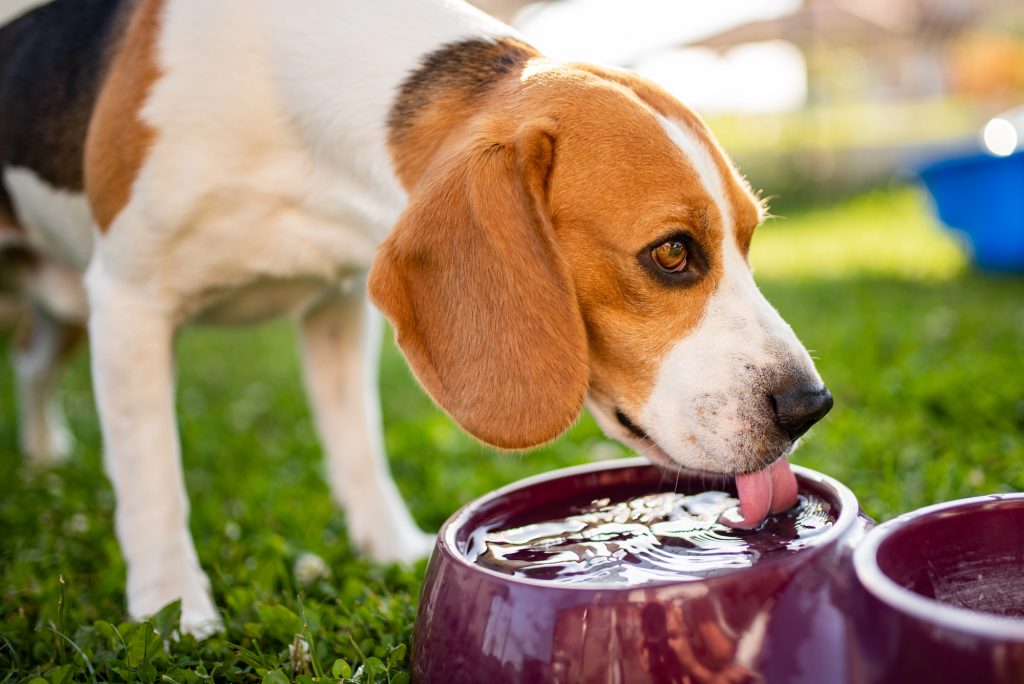It’s been 30 minutes since you returned from walking your dog. You enter the kitchen and notice your pup guzzling water from its bowl. This is unusual behavior, and you worry it’s dehydrated.
If you just returned from a walk, especially on a hot day, increased thirst is expected. However, dogs drinking a lot of water can also indicate a larger health issue, such as diabetes or kidney disease.
Understanding why your dog is drinking so much water is crucial to protecting its health. Explore common causes for increased thirst in dogs, and learn tips on how to monitor your furry friend’s water intake.
Why Dogs Drink a Lot of Water: Common Causes
Dogs drink a lot of water for various reasons. Some are entirely normal, while others may indicate an underlying health issue. Explore common causes of excessive thirst in dogs.
Normal Hydration Needs
Every dog has normal hydration needs, depending on its size, diet and activity level. For example, larger dogs need to drink more water than smaller dogs to maintain proper hydration. On average, your pup should consume 1 ounce of fluids per pound of its body weight.
Additionally, active dogs drink more to accommodate water loss through sweating during and after exercise. Certain foods also boost a dog’s water intake. Dry food lacks the water content wet or homemade foods contain, increasing thirst.
Regardless of your dog’s size or diet, increased thirst after exercising or being in hot weather is typical. This isn’t cause for concern unless your dog shows other symptoms.
Panting and Thirst
Dogs pant to regulate body temperature and activate water loss from their mouths and upper respiratory tract. This helps them cool down but also increases water consumption. If you’re wondering why your dog is panting so much, it may be hot, stressed or thirsty from exercising.
Exposure to hot weather and exercise encourages panting and excessive drinking to help dogs rehydrate. Additionally, dogs panting when they’re stressed or anxious prepares their body for fight or flight during uncomfortable situations.
Medical Conditions
Sometimes, excessive thirst in dogs indicates an underlying health issue. Diabetes mellitus, kidney disease and Cushing’s disease can all increase thirst in dogs. These conditions also cause other concerning symptoms, including increased urination, appetite changes and lethargy.
Some medications can also cause excessive thirst as a side effect, making your dog drink more. Look for unusual signs or symptoms when monitoring your dog’s behavior. If needed, consult a vet for an evaluation and advice on how to gauge whether your pup is drinking too much.

How to Know When Your Dog Is Thirsty
Knowing when your dog is thirsty and encouraging proper hydration is crucial for its overall health. Dog wellness tips to consider include:
- Following hydration guidelines. Ensure your pup drinks enough water based on its weight and activity level. For example, an active, 50-pound dog should drink a minimum of 50 ounces of water per day. Offer water after exercising, walking or playing fetch.
- Spotting signs of dehydration. Recognizing signs of dehydration in your furry friend can prevent serious health issues. When dehydrated, dogs often present physical and behavioral signs, such as dry gums, sunken eyes, dark urine and weakness. If your pup displays any of these symptoms, offer water and encourage it to drink.
- Maintaining healthy drinking habits. Make sure your dog’s bowl is regularly filled with fresh, clean water. Monitor how often you need to fill the bowl. If it’s staying full for too long, your pup may not be drinking enough. Offer your dog water breaks when playing or exercising to encourage drinking, especially in hot weather. Additionally, supply hydration-rich foods, such as strawberries or seedless watermelon, to increase fluid consumption.
With Halo Collar, you can create virtual fences that allow your dog to access hydration while they are enjoying their space.
When to Be Concerned About Your Dog Drinking Too Much Water
It’s normal for dogs to drink regularly, but excessive thirst can indicate something’s wrong. Signs of excessive water intake include:
- Drinking large amounts of water more frequently than usual
- Constantly seeking water, even after drinking a lot
- Increased urination, such as needing to go outside more frequently or having accidents in the house
If these signs occur alongside lethargy or appetite changes, your pup’s health may be at risk. Other symptoms to monitor include vomiting, diarrhea and straining when urinating. Consult a vet if your dog displays any of these symptoms. A vet can perform tests such as a urinalysis or blood work to determine the problem.
Monitoring your dog’s water intake can also help identify behavioral or health changes. For example, measure how much it drinks throughout the day to establish its regular drinking habits. Put a specific amount of water in your pup’s bowl in the morning and check how much is left at the end of the day.
If your dog drinks more than usual, especially for a few consecutive days, it may be drinking too much. Using a pet tech product, such as Halo Collar, can help track your dog’s activity to identify a potential reason for increased thirst.
Quench Your Curiosity (and Your Dog’s Thirst!) With Halo
Understanding your dog’s thirst levels can help protect its health. Your pup may drink more after exercising or being out in hot weather. However, symptoms such as weakness and vomiting should be looked at to identify whether a larger health issue is at play.
Using wireless GPS technology, Halo Collar can help track your dog’s activity in real-time to determine if increased thirst relates to exercise or other factors. You can also create customized virtual fences to keep your dog within designated hydration areas, enhancing safety.
Have fun bonding with your dog without worrying about risking dehydration or other health issues. Visit the Halo Collar website to learn how to foster a safe, active lifestyle for your pet.










